|
|
They Have Feathers? |
| Salukis come in two varieties - the
Smooth, having short silky hair all over their bodies,
and the Feathered. Yes feathered. This refers to the long
silky hair fringes on the ears, tail and rear of the
limbs. In Canada we see mostly the feathered variety,
although evidence suggests that in their Region of
Origin both smooth and feathered Salukis were
equally desired and were even bred together. Some
Bedouin tribes kept only the smooth variety, and all
Salukis were used for hunting, selected as breeding stock
based on hunting abilities. The differences in
tribal types were not initially recognized when breeding
was begun in other countries and continents therefore,
the varied tribal strains were mixed producing any number
of different color combinations appearing in the same
litter. |
| Some Saluki Coat Colours: | ||||||||

Red |

Fawn |

Cream |

Golden |

Tricolour |

Black & Silver |

Chocolate |

Fawn Grizzle |

Golden Grizzle |
In 1919, the National Geographic
Society's "The Book of Dogs" had this to say
about Salukis,
|
|||
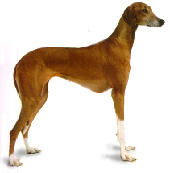 Azawakh |
It should be noted that there are several other breeds commonly mistaken for or thought of as a Saluki. The Azawakh and Sloughi, though similar in conformation, especially to the untrained eye, are not considered the same breed as the Saluki. There are visible differences in conformation to the trained eye and it is reported that there are genetic differences between them as well. The saluki is also sometimes thought of as a shorthaired version of an Afghan Hound which is also an untruth. There are several other breeds such as the Tazi and Rampur Hound that I am still gathering information on. | |
| These three sighthounds along with
the Saluki, grouped together because of their hunting
technique and common characteristics, are considered
separate breeds. They may have at one time come
from a common ancestor but when this ancestor was
distributed across the globe these breeds evolved
relatively independent of the influence from the others.
There is much debate as to whether these "breeds"
are indeed separate or variations (types) thereof and
though their similarities may pertain to a common
ancestry they undoubtedly pertain to the functions which
these hounds perform. They are all required to
course prey at high speeds. |
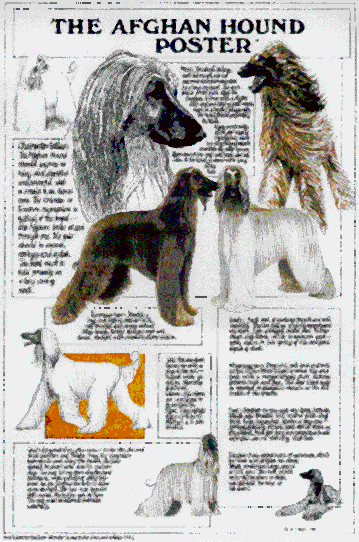 |
Sloughi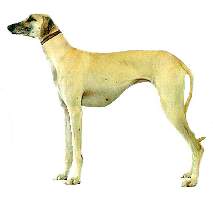 |
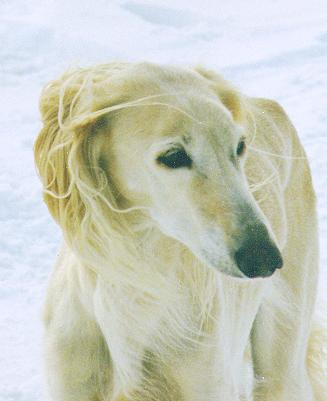 Ch. Iroki Belphoebe at age 13 |
Several features set the Saluki
apart from other breeds including their outline, movement
and temperament. The few
words of the Canadian Kennel Club (CKC) Saluki Standard describe a powerful endurance animal, an
intelligent, highly-bred, independent hunter who is built
and moves like no other hound. The
beauty of the Saluki is synonomous with that of the
Arabian horse; grace and symmetry of form, clean-cut and
graceful. Short silky hair on his body but much longer on the ears, legs and tail; slender well-muscled neck, shoulders, and thighs; arched loins; long tail carried naturally in a curve or circle with long silky hair hanging from the underside; the arched toes; the rather long head with deep far-seeing eyes; an expression of dignity mixed with gentleness. |
In the smooth variety of Saluki, the body, ears, tail, and legs are coated with short smooth hair much like that of the greyhound or whippet. There is a greater size range in the Saluki than in any other breed, from 23 inches in height to 28 inches in the males, and females proportionately smaller. Salukis were bred for the most economical size depending on the amount of food available. Where gazelles were the size of jack rabbits, the Saluki was a small hound; where the prey included the wild ass, the largest or "donkey" Saluki was needed. The Saluki's sight is famous. He can see clearly for at least a mile. Rather than watch a near-by object, a Saluki can often be seen gazing at a bird very high in the sky or at a passing plane. |
|
| <Back to the Main Index | Meet my Salukis or read on . . . | |
| Saluki Temperament | |
| The Saluki is a proud animal with
great depth of character and personality. Salukis
are truly a family hound and will not be happy if he
cannot share family life. It is
important that Saluki puppies be well socialized because
they can have the tendency, having been bred for
aloofness and independence, to be shy with strange
people, places and animals. A well socialized saluki is
comfortable almost anywhere. Very little physical
punishment is ever necessary for a misbehaving Saluki.
Their feelings are highly sensitive and for this reason,
repetition of punishment for the same misdemeanor is
seldom necessary. You may be shocked to know that Salukis
hold a grudge if reprimanded and they will let you know
for the next hour or so that you have insulted them.
Oddly enough, if they've been punished for something
which they know is not acceptable, they will most
certainly apologize with a great deal of tail wagging. |
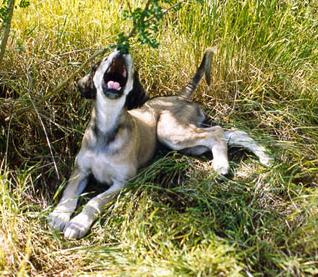 Iroki Oberon aka Darby |
| Salukis are not often thought of by
obedience trainers as intelligent because most people
think of canine intelligence in terms of trainability.
The saluki is trainable but because of inherent
behavioural attributes they rarely participate in silly
tricks and often disobey when called off lead.
Lately, however, there are more obedience trained Salukis
as the techniques for training become more reward
oriented as opposed to punishment based. But the Saluki
is first and foremost a hunter and the traits that the
Bedouin bred for are deeply ingrained. Salukis can also
be quite physically sensitive due to their low body fat
ratio and can be very vocal about pain (even perceived
pain). |
|
|
|
To own a Saluki you should, ideally,
have a large fenced yard. A Saluki pup is very fast so a
secure yard is essential for safety, unrestricted
exercise and your own piece of mind. The
Saluki requires lots of exercise to build strength and
stamina. Salukis are considered a large dog. Once a Saluki puppy has outgrown his inevitable awkward stage he will readily learn respect for your home and furniture to become a well behaved considerate houseguest. Salukis are very gentle and sensitive, enjoy the creature comforts of domestication and appreciate being allowed on a piece of furniture but beware of allowing him to usurp this seat from humans for he may take this as an indication of who's boss. Despite the Saluki's size they are adept at curling into a tightly wound ball and will not eat you out of house and home. An adult Saluki's appetite is quite modest and overweight problems are rare. |
| If you are interested in learning more about the Saluki or possibly adopting one into your own life, please research carefully. The Saluki is a very special creature and deserves a home where it will be loved and cared for as well as appreciated for it's unique qualities - which do not appeal to everyone. Contact a reputable breeder and spend time socializing with and observing the behaviour of their Salukis. Be well informed and enjoy getting to know this most wonderful canine! Feel free to E-mail me for more information or for a Canadian breeder reference. | |
| Early
Man Needs Dog | The
Ancients | Nomadic
Peoples | Function
& Form | Hunting Technique Saluki Explorers | They Have Feathers? | Temperament | Salukis In Art | Resources & Breeders |
|